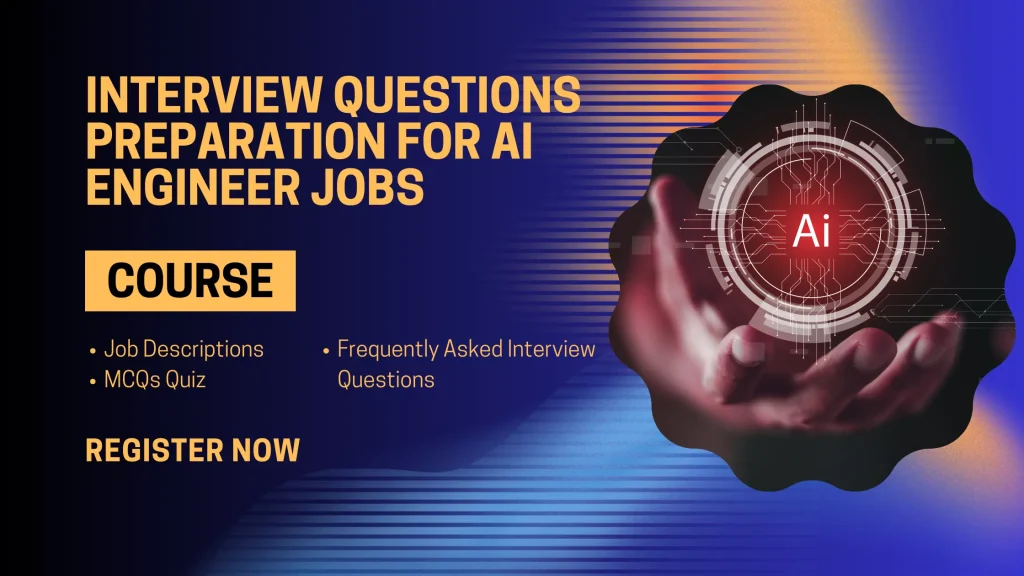Here are the interview questions and answers for AI (Artificial Intelligence) Engineer Jobs;
Question: What is Artificial Intelligence (AI)?
Answer: AI refers to the development of computer systems capable of performing tasks that typically require human intelligence, such as speech recognition, problem-solving, learning, and decision-making.
Question: Explain the difference between narrow (weak) AI and general (strong) AI.
Answer: Narrow AI is designed to perform a specific task, while general AI possesses the ability to understand, learn, and apply intelligence across a wide range of tasks, similar to human intelligence.
Question: What is machine learning?
Answer: Machine learning is a subset of AI that focuses on the development of algorithms allowing computers to learn from data and make predictions or decisions without explicit programming.
Question: Differentiate between supervised and unsupervised learning.
Answer: In supervised learning, the model is trained on a labeled dataset, where the output is known. In unsupervised learning, the model works on an unlabeled dataset, discovering patterns and relationships without explicit guidance.
Question: What is the purpose of a neural network in AI?
Answer: A neural network is a computational model inspired by the human brain, used in machine learning to recognize patterns, make decisions, and perform tasks like image and speech recognition.
Question: Explain the term “Deep Learning.”
Answer: Deep Learning is a subset of machine learning that involves neural networks with multiple layers (deep neural networks). It excels at capturing complex patterns and representations from large amounts of data.
Question: What is natural language processing (NLP)?
Answer: NLP is a field of AI that focuses on enabling machines to understand, interpret, and generate human language. Applications include language translation, sentiment analysis, and chatbots.
Question: Define reinforcement learning.
Answer: Reinforcement learning involves training a model to make sequences of decisions by receiving feedback in the form of rewards or penalties. It is often used in scenarios where an agent learns to navigate an environment to maximize cumulative rewards.
Question: What is the role of a Turing test in AI?
Answer: The Turing test is a measure of a machine’s ability to exhibit intelligent behavior indistinguishable from that of a human. If a machine can pass the Turing test, it is considered to possess human-like intelligence.
Question: Explain the concept of overfitting in machine learning.
Answer: Overfitting occurs when a model learns the training data too well, capturing noise and irrelevant patterns. As a result, it may perform poorly on new, unseen data.
Question: How does bias impact machine learning models?
Answer: Bias in machine learning refers to systematic errors that can occur if the training data is not representative. It can lead to unfair predictions and reinforce existing social biases.
Question: What are the main components of a machine learning pipeline?
Answer: A typical machine learning pipeline consists of data collection, data preprocessing, model training, model evaluation, and deployment.
Question: Explain the terms “precision” and “recall” in the context of classification models.
Answer: Precision measures the accuracy of positive predictions, while recall measures the ability of a model to capture all relevant instances of a positive class.
Question: What is the purpose of cross-validation?
Answer: Cross-validation is a technique used to assess a model’s performance by splitting the data into multiple subsets, training the model on different subsets, and evaluating its performance on the remaining data.
Question: What is transfer learning in the context of deep learning?
Answer: Transfer learning involves using pre-trained models on a specific task as a starting point for a new, related task. It helps leverage knowledge gained from one domain to improve performance in another.
Question: How does a Support Vector Machine (SVM) work?
Answer: SVM is a supervised learning algorithm used for classification and regression. It works by finding the hyperplane that best separates data points into different classes, maximizing the margin between classes.
Question: Explain the concept of clustering.
Answer: Clustering is an unsupervised learning technique that groups similar data points together based on their features. Common algorithms include K-Means and hierarchical clustering.
Question: What is the bias-variance trade-off?
Answer: The bias-variance trade-off refers to the balance between model simplicity (bias) and flexibility (variance). An overly complex model may have low bias but high variance, leading to overfitting.
Question: How does the Euclidean distance measure work in machine learning?
Answer: Euclidean distance measures the straight-line distance between two points in a multidimensional space. It is commonly used in clustering algorithms such as K-Means.
Question: What is a decision tree?
Answer: A decision tree is a tree-like model where each node represents a decision based on a feature, leading to further nodes or leaves that represent outcomes. It is used for classification and regression tasks.
Question: Explain the term “feature engineering.”
Answer: Feature engineering involves selecting, transforming, or creating new features to improve a model’s performance. It aims to provide relevant information to the model for better predictions.
Question: What is the role of activation functions in neural networks?
Answer: Activation functions introduce non-linearity to neural networks, enabling them to learn complex patterns. Common activation functions include ReLU (Rectified Linear Unit) and Sigmoid.
Question: How does a recommendation system work?
Answer: Recommendation systems use algorithms to analyze user preferences and behavior to provide personalized suggestions for items such as movies, products, or articles.
Question: What is the importance of data preprocessing in machine learning?
Answer: Data preprocessing involves cleaning, transforming, and organizing raw data to make it suitable for training machine learning models. Proper preprocessing enhances model performance.
Question: How do convolutional neural networks (CNNs) differ from traditional neural networks?
Answer: CNNs are specialized neural networks designed for processing grid-like data, such as images. They use convolutional layers to automatically learn hierarchical patterns and spatial hierarchies in data.
Join Our Course covering Job Description, Minimum Educational Qualification, Technical Skills, Analytical Skills, Certifications and Key Responsibilities for the AI Engineer Jobs

